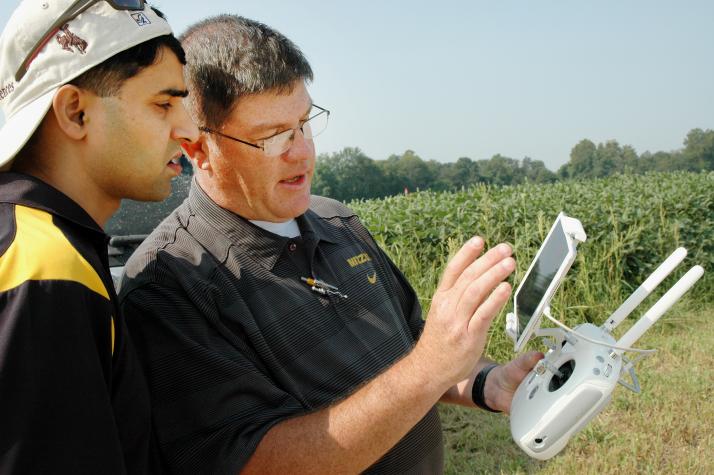COLUMBIA, Mo. – Drones are higher in quality and lower in price than they were just a few years ago when farmers began using them, says University of Missouri Extension natural resources engineer Kent Shannon.
Shannon gave an update on drone technology at MU Extension’s annual Crop Management Conference, Dec. 18-19 in Columbia. Shannon has taught farmers and extension educators how to use new technology for 25 years. His work put him on Successful Farming magazine’s recent list profiling 10 exceptional extension specialists.
Drone technology gives farmers new time- and labor-saving options, Shannon says. With the drone’s birds-eye view, row crop farmers can scout for disease, pest and nutrient problems in crops. Livestock producers can check herds, fences and water. Better technology overcomes weather and mobility issues.
Enhanced imaging allows farmers to zoom in on problem areas and respond quickly, he says. This results in better productivity and higher yields.
Shannon gave conference attendees a look at a recently released autonomous drone specially manufactured for agricultural use. The new industrial drone self-charges and self-manages. He also showed drones of varying prices and quality.
Shannon uses drones to scout fields in the MU Extension Strip Trial Program. Through their use, he quickly identified soybean cyst nematode in trial plots as well as other Missouri fields. He also has used drones to evaluate cover crop effectiveness.
Other MU Extension specialists use drones to capture plant infrared wavelength readings to find nitrogen deficiencies in crops. This allows producers to pinpoint nitrogen needs quickly. Producers can compare images from the growing season to yield maps in their nutrient management plans.
Using GPS technology, Shannon programs drones for flight over fields he scouts. In typical collection and processing, the workflow includes setup, flying time, data capturing, and data upload and processing. In a 60-minute flight, the operator can collect 3 gigabytes of raw data. Traditional image stitching—putting together numerous images into one image—is time-consuming. New software speeds the process and improves quality.
New technology shortens setup, flight, and data collection and management times.
Drawbacks still exist. Batteries drain quickly. Poor or nonexistent internet or cellular coverage in many rural areas still prevents farmers from downloading data in the field. This requires them to return to their home or office to retrieve data.
Shannon says drone operators who are providing their services as part of a business must hold a remote pilot certificate or work under the direct supervision of a pilot with a certificate. To apply for a certificate, a person must pass a test on aeronautical knowledge at an FAA-approved testing center or hold a Part 61 certificate. Individuals must be at least 16 years old and be vetted by the Transportation Security Administration.
The FAA still requires operators to be within line of sight of the drone. Pilots can fly only in daylight in limited airspace of no higher than 400 feet. Groundspeed of the drone must be under 100 mph.
